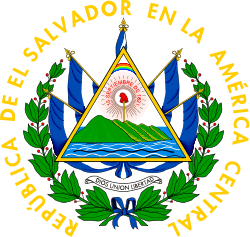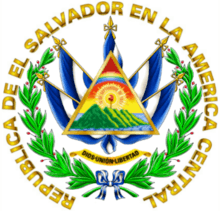Coat of arms of El Salvador
| Coat of arms of El Salvador | |
|---|---|
 | |
| Versions | |
 Seal of the President | |
| Details | |
| Armiger | Republic of El Salvador |
| Adopted | 15 September 1912 |
| Motto |
Dios, Unión, Libertad "God, Union, Liberty" |
The coat of arms of El Salvador has been in use in its current form since 15 September 1912.
Features

.jpg)
The coat of arms of El Salvador has Medieval Gothic influences as well as geographical, biblical, and Native American Indigenous symbolic representations, all of which come together in a distinctive, stylized shield design. Its center consists of a bold golden amber triangle outline (symbolizing the three branches of the country's government - Executive, Legislative and Judiciary), in which a row of five mighty and proud green forested coned volcanoes, depicting a tropical Jurassic landscape, rise out of the massive cobalt blue Pacific Ocean swells, symbolizing the fellowship of the five original isthmian member states of the United Provinces of Central America. The volcanoes are illuminated yellow on their right sides by sunshine. Above the volcanoes is a crimson red Phrygian cap on a staff before an amber sun with spiraling swirling rays, with a brilliant volcanic "red sky at morning" under the sun in the horizon. The date of the Independence Day of El Salvador, 15 September 1821, is written in black letters around the sun. On the top, there is a rainbow arch in an azure sky, a biblical symbol of peace. The colors in the rainbow from top to bottom are red, orange, yellow, green, and blue.
Behind the coat of arms there are five cobalt blue and white striped flags representing the flags of the Federal Republic of Central America; one of those flags is risen straight up behind and over the triangle, hanging loosely around its spear, and the other four flags are risen half way and stretch out like wings from behind the triangle's sides, two on each side, one over another. The flags hang loosely on their sides, creating almost a horn-like effect with their ends tied up behind the triangle's bottom.
All of the five flags are each held up and raised with Native American Indigenous wooden war spears, with obsidian Clovis projectile points, and tied with feathers, symbolizing El Salvador's American Indigenous ancestry and heritage. The spears represent the spirit and heroism of the Lenca and Pipil warriors, who defeated the first attempted Spanish conquest of Cuzcatlan. Spanish conquistador Pedro de Alvarado wrote that he was awestruck and spooked in great fear when he saw the massive numbers of American Indigenous warriors with large spears and bows as their weaponry standing their ground in their battle against the invading Spaniards.
Under the triangle, there is a golden amber scroll which states the national motto of El Salvador: Dios, Unión, Libertad (Spanish: "God, Union, Liberty") in boldface black capital letters.
The triangle, flags, and scroll are surrounded by a green laurel wreath tied together with a cobalt blue and white striped ribbon representing the national flag, which symbolizes unity. The laurel wreath is divided into 14 different parts, which symbolize the 14 Departments, the Salvadoran subnational administrative units. All this is surrounded by golden amber letters, which form the Spanish words REPÚBLICA DE EL SALVADOR EN LA AMÉRICA CENTRAL (English: Republic of El Salvador in Central America) in boldface capital letters. For special occasions, the whole entire coat of arms of El Salvador is stylized in amber gold color with a white or royal cobalt blue background. The coat of arms of El Salvador is also sometimes shown in silhouette.